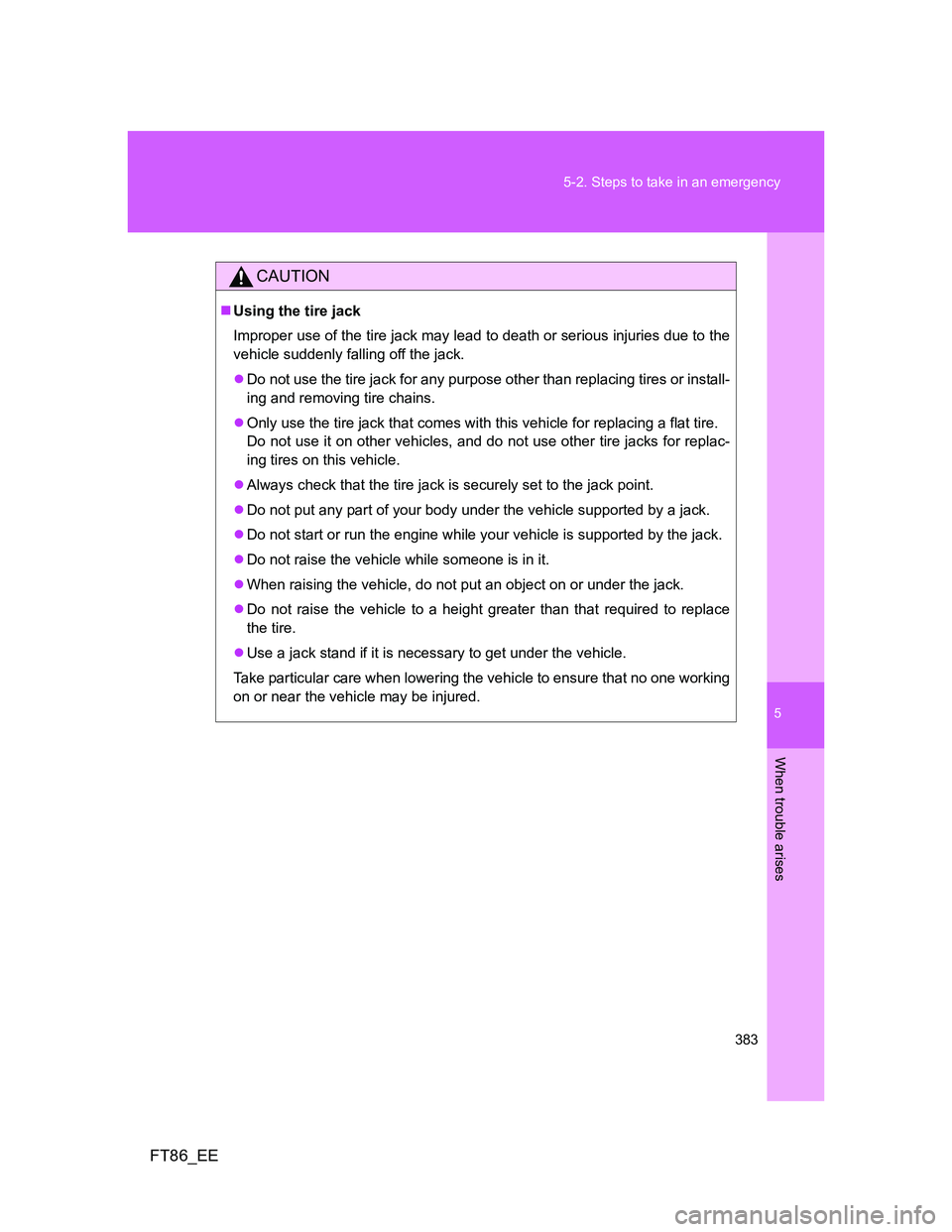Page 383 of 452

5
383 5-2. Steps to take in an emergency
When trouble arises
FT86_EE
CAUTION
Using the tire jack
Improper use of the tire jack may lead to death or serious injuries due to the
vehicle suddenly falling off the jack.
Do not use the tire jack for any purpose other than replacing tires or install-
ing and removing tire chains.
Only use the tire jack that comes with this vehicle for replacing a flat tire.
Do not use it on other vehicles, and do not use other tire jacks for replac-
ing tires on this vehicle.
Always check that the tire jack is securely set to the jack point.
Do not put any part of your body under the vehicle supported by a jack.
Do not start or run the engine while your vehicle is supported by the jack.
Do not raise the vehicle while someone is in it.
When raising the vehicle, do not put an object on or under the jack.
Do not raise the vehicle to a height greater than that required to replace
the tire.
Use a jack stand if it is necessary to get under the vehicle.
Take particular care when lowering the vehicle to ensure that no one working
on or near the vehicle may be injured.
Page 391 of 452
5
391 5-2. Steps to take in an emergency
When trouble arises
FT86_EERemove the injection hose from
the valve and screw the valve
core in the valve securely by
turning it clockwise with the
valve core tool.
Attach the sticker as shown.
Remove any dirt and moisture
from the wheel before attaching
the label. If it is impossible to
attach the label, make sure to tell
any authorized Toyota dealer or
repairer, or another duly qualified
and equipped professional when
you have them repair and replace
the tire that sealant is injected.
Store the kit and then attach the
sticker as shown.
STEP 9
Va l v e
core tool
Va l v e c o r e
STEP 10
STEP11
Page 397 of 452
5
397 5-2. Steps to take in an emergency
When trouble arises
FT86_EE
CAUTION
When fixing the flat tire
Stop your vehicle in a safe and flat area.
If force is used to turn the valve core tool while air remains in the tire, spe-
cial care should be taken because the valve core could fly out.
Be careful, as sealant may fly out if you shake the bottle with the hose
installed.
Do not touch the wheels or the area around the brakes immediately after
the vehicle has been driven.
After the vehicle has been driven, the wheels and the area around the
brakes may be extremely hot. Touching these areas with hands, feet or
other body parts may result in burns.
Connect the valve and hose securely with the tire installed on the vehicle.
If the hose is not properly connected to the valve, air leakage may occur
as sealant may be sprayed out.
If the hose comes off the valve while inflating the tire, there is a risk that
the hose will move abruptly due to air pressure.
Page 420 of 452
420 5-2. Steps to take in an emergency
FT86_EE
CAUTION
If the engine has to be turned off while driving
Power assist for the brakes and steering wheel will be lost, making the
brake pedal harder to depress and the steering wheel heavier to turn.
Decelerate as much as possible before turning off the engine.
Vehicles without a smart entry & start system: Never attempt to remove
the key, as doing so will lock the steering wheel.
Vehicles with a smart entry &
start system: To stop the
engine, press and hold the
“ENGINE START STOP”
switch for 2 consecutive sec-
onds or more, or press it
briefly 3 times or more in suc-
cession.
Stop the vehicle in a safe place by the road.
Press and hold for 2 seconds or more,
or press briefly 3 times or more
STEP 4
STEP 5
Page 440 of 452
440
FT86_EE
Abbreviation list
Abbreviation/Acronym list
ABBREVIATIONSMEANING
ABS Anti-lock Brake System
ACC Accessory
AI-SHIFT Artificial Intelligence Shift
CRS Child Restraint System
DISP Display
ECU Electronic Control Unit
EDR Event Data Recorder
ELR Emergency Locking Retractor
EPS Electric Power Steering
LED Light Emitting Diode
LSD Limited Slip Differential
SRS Supplemental Restraint System
TRC Traction Control
VIN Vehicle Identification Number
VSC Vehicle Stability Control